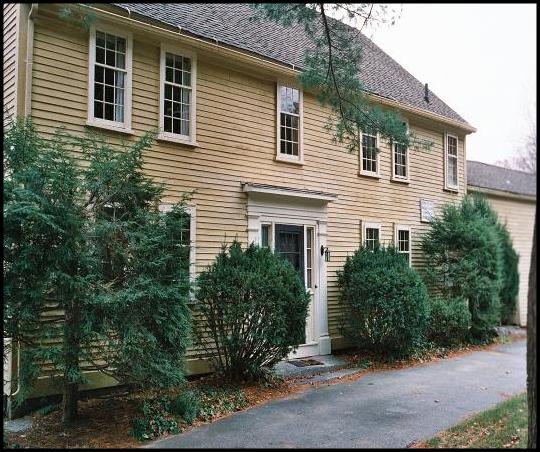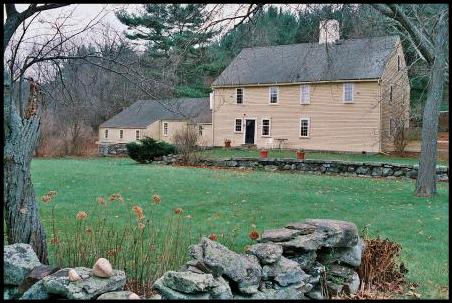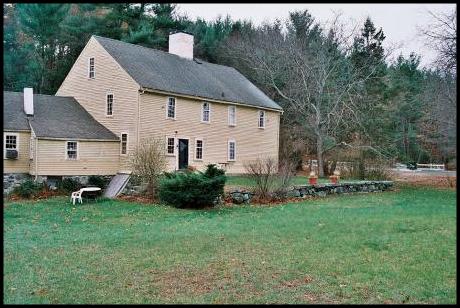



Pelatiah Fletcher House, Westford Massachusetts, Built c.1690
FEATURES OF THE HOUSE
The Pelatiah Fletcher House has many unique features: a “Witch’s Staircase”, “Indian Shutters”, a “Beehive Oven”, a “Parson’s Cupboard”, a 24-inch-wide board, and roof beams as tough as petrified wood! The beams were probably from the first cut of the forest and were the strongest wood. The house has five fireplaces, three on the first floor and two on the second. The “Witch’s Staircase” is perhaps the most interesting feature of the house. When you open the attic door you see three steps and the chimney, and then more steps that turn to the right and go up to the attic. To the left of the chimney is another stairway about 10-12” wide, but one of the planks is missing! The family believed that the witch who was traditionally nocturnal, and also had poor eyesight, would not notice this missing plank, trip and fall, hit her head on the attic door, and wake up the sleeping family who would then shoot her!
The first room (the Southeast room with the “Pelatiah Fletcher” plaque above it) was built around 1690 and had “Indian Shutters” designed to stop arrows. The walls in this part of the house are thicker, and inside the walls are sliding wood panels that pull out from the right side of the window to protect the window area and to help stop the arrows. As the house was expanded, these shutters were not used in any other part of the house.
A “Beehive Oven” is used for baking and is heated by the fireplace.
The “Parsons Cupboard” is above the mantelpiece and was used to store the offerings to peripatetic ministers. It may have contained various religious books, writings and perhaps libations.
The “Weaving Room” (to the east side of the house as you face it) was an addition to the structure and was used for making clothes, dyeing fabrics, and sewing. This room was the largest room in the home. It is not part of the replica of the house, but can be viewed for real on Lowell Road.
Under the chimney is a “Root Cellar” with a rounded roof (the base of the chimney). This area had a more relatively cool temperature than any other part of the house and would have been used for storage.
The room in the northwest corner of the house on the first floor is called the “Borning Room”. It was the warmest room in the house, close to the kitchen and dining room, received the afternoon sun from the west, and was dedicated to birthing and caring for the very young.
Until 1955, all of the inhabitants of this house got their water from a Dug Well, which was just a few feet from the house. The well had a bucket with a counter weight to help raise the bucket, but there wasn’t enough water for a family of six, so my father decided to dig an artesian well. The well-drilling company drilled down through twenty feet of top soil and then hit granite for another 200 feet! We thought the drilling would never end! The water that they pumped up had high iron content and had to be treated with an elaborate filtering system in the basement in order to become potable.
MY RECOLLECTIONS
When I moved into the house in 1955, the floors were buckled from lack of heat. The house had no insulation, electrical wiring or plumbing system as we know them today. The previous owner, LuAnna DeCatur, had lived mostly in the parlor and kitchen areas, and could not maintain the house by herself in her latter years. In 1955 my father bought the house from LuAnna for $18,500. This included 13 acres behind the house and 75 acres of hills across the street, the tribal home of the Tadmuck Indians in the 1600’s.
I remember that my father brought an ice pick with him when we first looked at the house, and I asked him why he had brought it. He soon showed me by trying to jab it into one of the roof timbers in the attic to see how far in it would go. Hardly at all…these beams are solid! There was hardly anything electrical in the house in 1955, and the electricians broke a lot of drill bits wiring the house due to the hardness of the wood, and it took them a very long time. When I toured the house as an adult, I was surprised at how small it seemed. Not only was I a child when we lived there, but the people who built it were smaller in stature than we are today. You have to duck your head to walk around in the basement. The granite blocks of the foundation were quarried locally.
OTHER ITEMS OF INTEREST
Across the street and up the hill was the Tadmuck Indian’s Grist Mill. It is simply a large hole in a rock into which corn was put and ground with a pestle, which in this case was a large egg-shaped rock.
|

|
Back of House. Note that there are no windows on the right side...that was the Borning Room. |

|
Weaving Room to the left. Carriage/Car Housing. |
